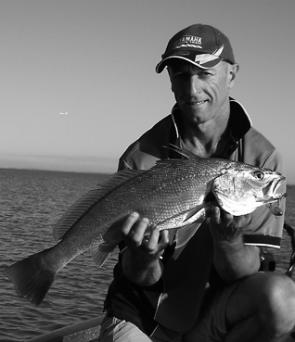Traditionally November is a great month to fish the Brisbane River. Banana prawns are on the move, small hardiheads are starting to school along the rock walls at the mouth, sand and mud crabs become readily available, larger tides change from night to day and the quality of fish definitely increases.
If my last couple of trips to the river are anything to go by, this summer will bring awesome fishing for Brissie locals. We’ve been catching large numbers of smaller snapper, jew and javelinfish (with the odd bigger specimens) in most of the deeper holes around shipping docks and rock walls from the mouth all the way upstream to the Hamilton reach.
At this time of year, predatory fish continually move around with the schools of prawns and small baitfish and anglers often have to relocate – sometimes many, many times – to find and catch these fish. On any given day, snapper can be caught in the shallows along rock walls to deep holes in 60ft of water or wherever the available food source is stationed.
During November and over the next couple of months, the fish will be wherever the bait is. At this time of year it can be frustrating trying to locate bait and fish due to their continual movements. Once you have located the fish on your sounder, however, you can get multiple captures in quick succession with a well presented soft plastic or vibration bait.
Bait anglers will catch fish in most of the usual spots. Having said that, you have to be prepared to find the fish before anchoring, or to continually move around looking for fish, or you’ll have some fishless days.
Areas to try can vary dramatically from day to day. To start with, try fishing shallow flats along the river where boats moor, such as opposite Breakfast Creek at Bulimba. Prawns like sallowish flats with boat moorings at times, and there are more flats worth exploring along this stretch of river in different locations back towards Bulimba Creek. The next day, however, they may have shifted to a totally different location like the deepest dredged holes in front of shipping wharves.
Due to the prawns vanishing one day and magically appearing back in the same area days later, you need to have an open mind and establish a ‘milk run’ of locations between flats, rock walls, deep rock bars and shipping wharves.
On most of my ventures into the river I start by searching at the mouth, fishing in deep water towards the shipping terminals and then I’ll head upstream. Or I might do the complete opposite and start fishing deep along the Hamilton stretch and then move towards the mouth. Either way, I always start in deep water and move to the shallows. Why? Because if I find fish in deep water they usually respond to artificials better than the fish in the shallower areas do.
If I can’t locate fish around shipping terminals, I fish natural rock structures instead, again starting in deep water and then moving shallower. Most times I can find reasonable concentrations of fish in deep water. If fish cannot be found along different shipping terminals or one of the many rocky ledges that stretch from the city and beyond all the way back to the mouth then the fish must be in the shallows.
When fishing the shallows in the river it’s best to keep a sharp eye out for surface activity and only use your sounder to judge the depth of water to manoeuvre the boat. Snapper often feed in incredibly shallow water along most of the manmade rock retaining walls that line the river. When fish are feeding in the shallows there are some telltale signs to look for: showering schools of hardiheads, prawns skipping along the surface, green turtles continually surfacing, and nervous mullet shimmering close to the surface. The latter is a good sign that there are jew in the area.
I fish two different techniques in the river. The first technique is what I call ‘prospecting’, and I do this with vibration bait like an Ecogear VT65 or Jackall Mask or Tranzam. Vibration baits are heavy, work well in current, can be controlled in most conditions and are fish attractants, so I use these baits to cover ground looking for concentrations of fish.
Once I have identified fish on my sounder I switch to a different technique and fish with plastics. My second technique, presented to the fish that I can see on my sounder, is more subtle. I mainly use Ecogear Powershads, Para Max and Grass Minnows rigged on jigheads between 1/8 and 1/4oz. Most fish you will see on your sounder will be suspended at a particular depth, and by fishing vertically underneath your transducer you will continually be in the strike zone and produce results. Anglers that just drag and hop their plastics along the bottom are missing lots of fish that feed mid-water.
All up, the river is fishing well and will continue to produce over the next couple of months – and if we get some flushing rain during this period it will only get better. It’s worth putting a few crab pots out when fishing because there are plenty of crabs around the mouth and in the usual spots towards the city.
[CAPTIONS]
1. Harry Watson with a small jew caught on a Jackall Mask at the mouth of the river.
2. Typical show of snapper suspended off the bottom. This shot was taken under the Gateway Bridge.
3. Chloe Dunne with a nice sand crab from the river. Crabs are on the move at the moment.
Reads: 2266






